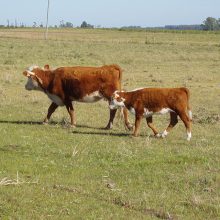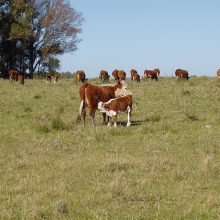Herbage allowance affects grazing and maternal behaviour of beef cows grazing rangelands
The animal Article of the Month for July is “Metabolic hormones, grazing behaviour, offspring physical distance and productive response of beef cow grazing at two herbage allowances” by M. Claramunt et al.
Experiments and cow-calf farm studies in rangelands showed that cow-calf performances increase with herbage allowance (when the annual mean increases from 2.5 to 4 kg DM/kg LW). Pregnancy rates, calves´ weaning weight, efficiency of forage use as well as meat production per surface area are all improved. Those improvements were associated with greater herbage mass, and cow nutritional status that may affect cows´ grazing behavior and maternal investment.
The present study tested those two levels of herbage allowance (2.5 to 4 kg DM/kg LW) during the second third of gestation and lactation in primiparous cows that are more sensitive to limited nutritional supply. We studied the cows’ nutritional status, grazing behavior and cow-calf bond at the start of the breeding seasons when temporary weaning of calves (carried out by applying nose plates on calves for 12 days) with flushing of cows (2 kg/day of whole-rice bran for 22 days) at the start of the breeding season were applied. This technique induces a temporary reduction of milk yield and an increase in energy intake improving the pregnancy rates of cows with low body condition score.

The experimental area experienced a drought period where sward severely limits herbage intake in both treatments. Under this condition, grazing was reduced while rumination and idling times increased reflecting the improvement of cows’ nutritional status that could help to attenuate the higher energy costs associated with locomotion and stress when animals graze under drought conditions.
High herbage allowance led to a more pronounced reduction in grazing time, and to increased walking during flushing. This reflects a reduction in grazing activity and their associated energy expenditure, combined with a higher investment to search for better grazing locations. It is possible that cows offered high herbage allowance adopt this grazing strategy due to their better nutritional status and the slightly greater herbage mass.

High herbage allowances also lowered physical distance of cow-calf pairs indicating a greater cow-calf attachment associated to the better cow nutritional status. We speculate that the lower grazing time with high herbage allowance could also contribute to a reduction in cow-calf physical distance. By contrast, the cow-calf physical distance greatly increased after flushing at low herbage allowance, suggesting a weakening in the bond that could affect calves´ weight gains.
Our study identified that cows´ nutritional status, grazing behavior and cow-calf attachment are linked together, and contributes to explaining the productive responses of cows and calves. We recommend taking into account the females’ nutritional status in models and studies on grazing, maternal behaviours and offspring growth.
The animal Article of the Month for July “Metabolic hormones, grazing behaviour, offspring physical distance and productive response of beef cow grazing at two herbage allowances” is free for a month.
Authors: M. Claramunt, A. Meikle and P. Soca
The animal Article of the Month is selected by the Editor-in-Chief and is freely available for one month. View the recent selections
Photo credit: Martín Claramunt et al.






